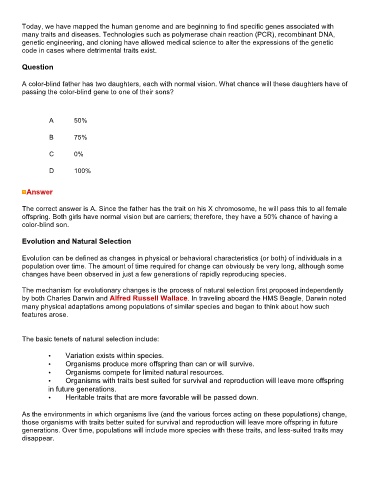Page 314 - ABCTE Study Guide_Neat
P. 314
Today, we have mapped the human genome and are beginning to find specific genes associated with
many traits and diseases. Technologies such as polymerase chain reaction (PCR), recombinant DNA,
genetic engineering, and cloning have allowed medical science to alter the expressions of the genetic
code in cases where detrimental traits exist.
Question
A color-blind father has two daughters, each with normal vision. What chance will these daughters have of
passing the color-blind gene to one of their sons?
A 50%
B 75%
C 0%
D 100%
Answer
The correct answer is A. Since the father has the trait on his X chromosome, he will pass this to all female
offspring. Both girls have normal vision but are carriers; therefore, they have a 50% chance of having a
color-blind son.
Evolution and Natural Selection
Evolution can be defined as changes in physical or behavioral characteristics (or both) of individuals in a
population over time. The amount of time required for change can obviously be very long, although some
changes have been observed in just a few generations of rapidly reproducing species.
The mechanism for evolutionary changes is the process of natural selection first proposed independently
by both Charles Darwin and Alfred Russell Wallace. In traveling aboard the HMS Beagle, Darwin noted
many physical adaptations among populations of similar species and began to think about how such
features arose.
The basic tenets of natural selection include:
• Variation exists within species.
• Organisms produce more offspring than can or will survive.
• Organisms compete for limited natural resources.
• Organisms with traits best suited for survival and reproduction will leave more offspring
in future generations.
• Heritable traits that are more favorable will be passed down.
As the environments in which organisms live (and the various forces acting on these populations) change,
those organisms with traits better suited for survival and reproduction will leave more offspring in future
generations. Over time, populations will include more species with these traits, and less-suited traits may
disappear.

